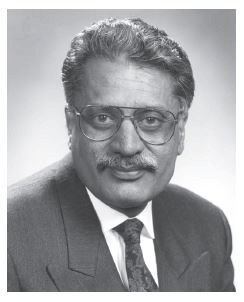Dr Gur Sharan Singh, 1936–2015

Dr Gur Sharan Singh was born on 25 September 1936 in the city of Jullundur, Punjab, India. He earned his medical degree at Punjab University, India, in 1959 and trained in neurosurgery at the University of Rochester in New York, Queen’s University in Ontario, and at McGill University in Montreal. After a short period in Victoria, he established a busy and extensive neurosurgery practice in Kamloops in 1967, which is where he and his family settled and have lived to date. Dr Singh was the first neurosurgeon to work in British Columbia’s Interior. He developed an extensive practice in spine surgery and had a referral practice from neighboring provinces and many US states.
Dr Singh wound up his full-time practice in 1993 but continued his consulting and surgical assist work for many years after retirement. He served as a member of WorkSafeBC’s Medical Review Panel and as medical member to the Canada Pension Plan Tribunal in 1997. During his years of practice, Dr Singh participated and played a leadership role in the professional affairs of neurosurgery practice, serving for the Section of Neurosurgery and as director of the neuro-services unit at Royal Inland Hospital. Later in life Dr Singh was asked to come back to Royal Inland Hospital in Kamloops as the medical chief of staff.
Besides dealing with a busy and demanding practice, Dr Singh devoted time and energy toward making a contribution to the profession. I had the honor of working with Gur during his very active leadership role with Doctors of BC (then BCMA). He was a member of the executive and served as president of the association for 1991–1992. It was during that year that Dr Singh’s leadership qualities became evident when the profession was faced with difficult threats of some draconian legislative challenges. Dr Singh worked with the Board of Directors, his executive team, and staff to mobilize the profession and mount a major challenge to the proposed legislation. His leadership was supported and appreciated by the profession, as evidenced by a 2000-strong packed rally at the Vancouver Convention Centre, which gave him several rousing and standing ovations. I had the distinct privilege to be with Gur during negotiations, and his firm but fair hand remained a guiding post throughout that year. His sense of fairness, honesty, and integrity was paramount to a successful outcome. Patients and the profession were well served during that trying year. He will be remembered by us all for that great contribution along with his policy development work at the association. Dr Singh was also founding chair of the Council on Health Economics and Policy. The profession is stronger and better because of his foresight and leadership in these areas. His contribution of bringing successful closure to registered pension benefits for the profession is a lasting legacy.
Gur was also a talented athlete and took an active interest in sports; he especially enjoyed tennis. He served as president of the Kamloops Tennis Club and he could often be found at Kamloops Blazers games along with his son. He took on golf with gusto and established a local golf tournament fundraiser. The event has raised over $1.25 million for the Kamloops Brain Injury Association. He and his family supported many local community organizations, giving their time as volunteers. He volunteered at the 1993 Canada Summer Games and chaired the Rotary Club and Heart and Stroke Foundation’s projects on smoke-free schools.
Gur was a devoted family man and had the full support of his wife, Manju, and their children, Sabina and Arjun, for all his work. I vividly remember the September 1991 issue of the BCMJ when both Manu and Gur were featured on the cover. His friends, colleagues, and family were enriched, and he will be missed by us all. Rest in peace my brother and friend.
—Arun Kumar Garg, MD
New Westminster

In 1974 I was hitchhiking in the Caribou region when the car that picked me up was involved in a head-on collision. Itaken to Royal Inland Hospital, paralyzed from the waist down and in utter agony from searing spinal pain. I was such a mess that the doctors didn't want to operate at all for several days. Finally, when things didn't become better or clearer, Dr. Singh operated on my mess of a spine. I believe it is because of him that I can walk today. Some of it must be luck, but I believe I was lucky to have Dr. Singh operate on me. I think of him periodically and give thanks once more. It was a pleasure to read this article and have some small glance into the person he was.